
This is another installment of a favorite topic of mine: reducing meat consumption without fully discarding its unchallengeable, unique contributions to cuisine. This post also follows in the tradition of “simple meals for a busy schedule.” I’m going to look at a winter pasta and the effect of a hidden ingredient, the humble anchovy.
The sauce is slow-poached cauliflower. Here I am tossing it with pasta, but it would pair well with polenta or white beans or gnocchi. (Admittedly, “slow-poached” is somewhat redundant, but I like the sound of it.) The meat inclusion is so negligible, so hidden, that it doesn’t even warrant a place in the title. I am using anchovy—good, old fashioned, in the jar, lasts forever, much maligned anchovy. By the time we get through with it you will not remember that it is there, and your squeamish guests will not detect it; only your ethics need determine whether you inform them of its presence ahead of eating (personally, I warn vegetarians and don’t mention it to omnivores).
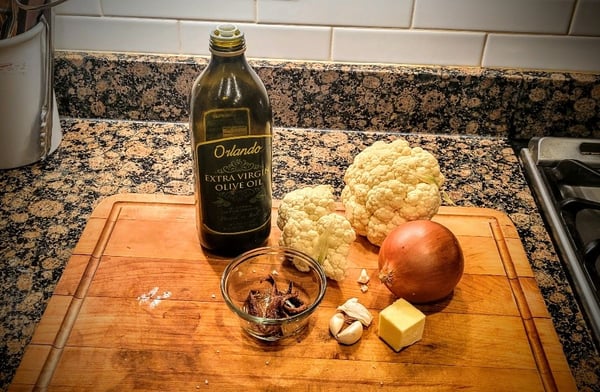 Our prejudice against anchovies is typically based on an experience early in life. An otherwise delectable pizza had, in an affront to humanity, been sown with great slithers of pungent, salty pink-brown filets. The smell was dizzying. Decades would pass before entertaining a reconsideration of those not-so-innocuous creatures. Now admittedly, these days I am not beyond eating a whole filet on its own, perhaps half of the time it is intended to shock one of my young’uns, as I did the other day. On their own, a cured anchovy fillet is an amusement park ride: not a roller coaster with twists and turns, but one of those single free-falls where you experience three hours in eight seconds. This approach does appear in cuisine, as was discussed in this blog from May documenting Basque pintxos.
Our prejudice against anchovies is typically based on an experience early in life. An otherwise delectable pizza had, in an affront to humanity, been sown with great slithers of pungent, salty pink-brown filets. The smell was dizzying. Decades would pass before entertaining a reconsideration of those not-so-innocuous creatures. Now admittedly, these days I am not beyond eating a whole filet on its own, perhaps half of the time it is intended to shock one of my young’uns, as I did the other day. On their own, a cured anchovy fillet is an amusement park ride: not a roller coaster with twists and turns, but one of those single free-falls where you experience three hours in eight seconds. This approach does appear in cuisine, as was discussed in this blog from May documenting Basque pintxos.
But there is another way for these tiny fish to contribute to our table, one that is simultaneously more restrained (more of a Sunday drive than that amusement park thrill ride), longer lasting, and arguably more dynamic. When dispersed in a sauce, the intense flavor, the fishiness, becomes undetectable while the umami, the je ne sais pas, veils out through your dish. This chef tool hides all over the place, such as in classic Green Goddess dressing, as well as countless Italian dishes that thrilled you but you couldn’t quite duplicate at home.
When I started working on this blog theme back in February, I proposed an otherwise vegetarian dish with the optional addition of a cured meat, lox. This dish I am presenting today can be approached similarly. You could eliminate the anchovy to make it vegetarian, on top of which you could garnish with optional chopped anchovies. This creates a very different effect, enjoyable but more intense as you occasionally encounter the odd bit of straight anchovy: tiny yet bracing.
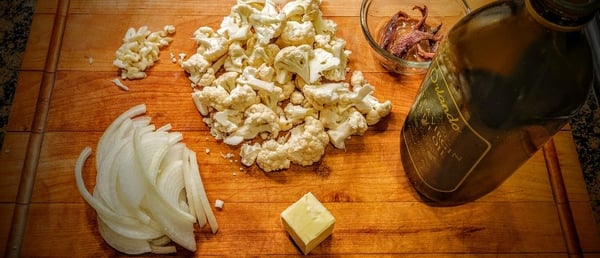 But today I want to fully incorporate the fish in an act of culinary sublimation. I am going to create a flavor base by slowly poaching onions in butter and extra virgin olive oil. Because my temperature is so low my normally delicate butter and olive oil will not burn, as they may normally if frying for an extended time. For this, I slice the onions thinly across their grain instead of with it as I almost always do. This will aid them to break apart more, to melt into the oil. From the start, I also add a toss of chili flake to start warming the palate. I encourage the onions to wilt by covering them, thus steaming them as I keep the pan cool; the oil will not get hot enough to brown the ingredients—I don’t want caramelization. Once the onions are well collapsed, I add some garlic and minced anchovy and continue along the same path, low and lidded.
But today I want to fully incorporate the fish in an act of culinary sublimation. I am going to create a flavor base by slowly poaching onions in butter and extra virgin olive oil. Because my temperature is so low my normally delicate butter and olive oil will not burn, as they may normally if frying for an extended time. For this, I slice the onions thinly across their grain instead of with it as I almost always do. This will aid them to break apart more, to melt into the oil. From the start, I also add a toss of chili flake to start warming the palate. I encourage the onions to wilt by covering them, thus steaming them as I keep the pan cool; the oil will not get hot enough to brown the ingredients—I don’t want caramelization. Once the onions are well collapsed, I add some garlic and minced anchovy and continue along the same path, low and lidded.
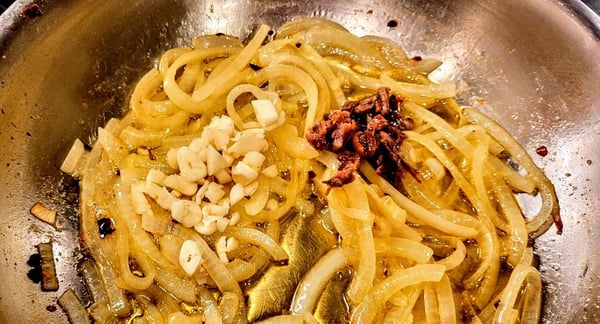 Then I add my cauliflower and at this point, I add some water under my lid to steam them. Typically when I cook cauliflower (as well as just about all other vegetables) I aim for al dente—cooked through yet still firm with a touch of snap. This dish cooks it gently for twenty minutes to guide them to a state of sumptuous creaminess.
Then I add my cauliflower and at this point, I add some water under my lid to steam them. Typically when I cook cauliflower (as well as just about all other vegetables) I aim for al dente—cooked through yet still firm with a touch of snap. This dish cooks it gently for twenty minutes to guide them to a state of sumptuous creaminess.
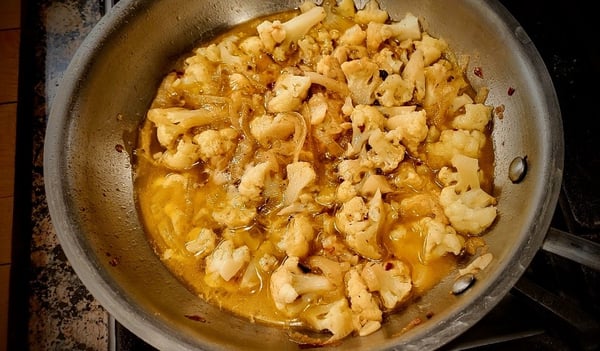 The texture of the vegetables, the complimenting duo fats, and the umami of the anchovy, as well as a final toss of good Parmigiano Reggiano, combine to make a very warming blanket. Finally, in contrast and as a snap back to the present, I top the dish with fresh parsley and lemon zest, as well as raw walnuts for crunch.
The texture of the vegetables, the complimenting duo fats, and the umami of the anchovy, as well as a final toss of good Parmigiano Reggiano, combine to make a very warming blanket. Finally, in contrast and as a snap back to the present, I top the dish with fresh parsley and lemon zest, as well as raw walnuts for crunch.
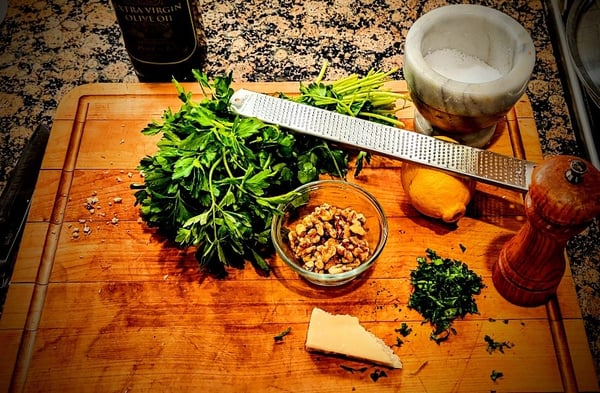 This is a dish for cold months. For a lesson on a different cold weather pasta, consider our virtual class on Pasta Carbonara coming up on Friday, December 16 at 6pm CST, or a private virtual lesson on how to build a successful pasta sauce.
This is a dish for cold months. For a lesson on a different cold weather pasta, consider our virtual class on Pasta Carbonara coming up on Friday, December 16 at 6pm CST, or a private virtual lesson on how to build a successful pasta sauce.
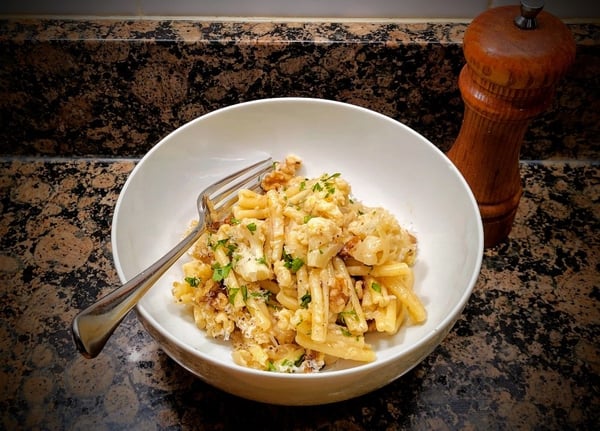
Slow-Poached Cauliflower
Scroll down for a printable version of this recipe
Yield: 4 portions
Prep time: 10 minutes
Cook time: 30 minutes
Start to finish: 40 minutes
3 Tablespoons extra virgin olive oil
2 Tablespoons unsalted butter
1/2 teaspoon chili flakes
1 cup sliced onion (half of a medium sized onion, cut against the grain)
3 cloves garlic, roughly chopped small
4 anchovy fillets, roughly chopped small
3-4 cups cauliflower (about half a large head of cauliflower), cut into small florets
Water to maintain a depth of 1/4 inch
Salt and black pepper
8 ounces dry pasta of your choice, cooked. (Alternately, top polenta or a bowl of white beans.)
1/2 cup Parmigiano Reggiano, finely grated (I prefer a Microplane for the job.)
1/4 cup chopped parsley
1 lemon, finely zested
1 cup raw walnuts, crushed in hand, or lightly toasted almonds or pine nuts
- Heat a 12” fry pan on a medium-low burner and add the olive oil, butter, chili flakes and onion. Cover and let the onions wilt and slowly tenderize without browning. This may take about 10 minutes.
- When onions are very soft, mix in the garlic and anchovy. Replace the lid and cook another 3 minutes.
- Add the cauliflower, water, and a light seasoning of salt and pepper and cover again for 10 minutes.
- Meanwhile, boil the pasta in lightly salted water, chop the parsley and zest the lemon. Drain the pasta and mix in about 2/3 of the cheese. There should still be some cooking liquid in the pan, and the cheese should melt into the water to enrich it.
- Check for seasoning, dish out and top with a dusting of more cheese, parsley, zest and nuts.
For Part 1 in this blog series Using Meat as Seasoning Agent, click here.
For Part 2 in this blog series Using Meat as a Seasoning Agent, click here.
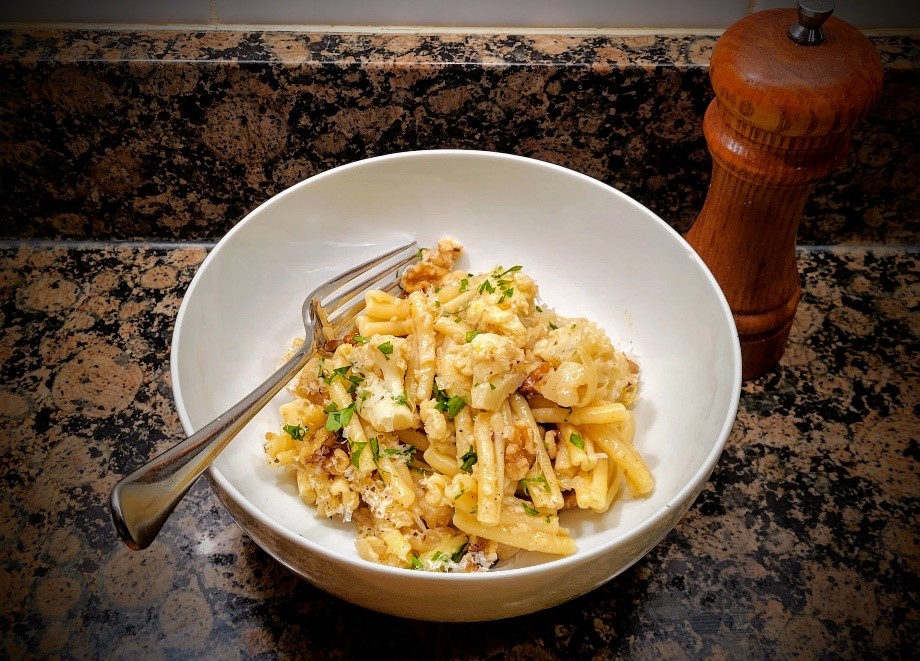
Slow-Poached Cauliflower
Ingredients
- 3 Tablespoons extra virgin olive oil
- 2 Tablespoons unsalted butter
- 1/2 teaspoon chili flakes
- 1 cup sliced onion (half of a medium sized onion, cut against the grain)
- 3 cloves garlic, roughly chopped small
- 4 anchovy fillets, roughly chopped small
- 3-4 cups cauliflower (about half a large head of cauliflower), cut into small florets
- Water to maintain a depth of 1/4 inch
- Salt and black pepper
- 8 ounces dry pasta of your choice, cooked. (Alternately, top polenta or a bowl of white beans.)
- 1/2 cup Parmigiano Reggiano, finely grated (I prefer a Microplane for the job.)
- 1/4 cup chopped parsley
- 1 lemon, finely zested
- 1 cup raw walnuts, crushed in hand, or lightly toasted almonds or pine nuts
Instructions
- Heat a 12” fry pan on a medium-low burner and add the olive oil, butter, chili flakes and onion. Cover and let the onions wilt and slowly tenderize without browning. This may take about 10 minutes.
- When onions are very soft, mix in the garlic and anchovy. Replace the lid and cook another 3 minutes.
- Add the cauliflower, water, and a light seasoning of salt and pepper and cover again for 10 minutes.
- Meanwhile, boil the pasta in lightly salted water, chop the parsley and zest the lemon. Drain the pasta and mix in about 2/3 of the cheese. There should still be some cooking liquid in the pan, and the cheese should melt into the water to enrich it.
- Check for seasoning, dish out and top with a dusting of more cheese, parsley, zest and nuts.

